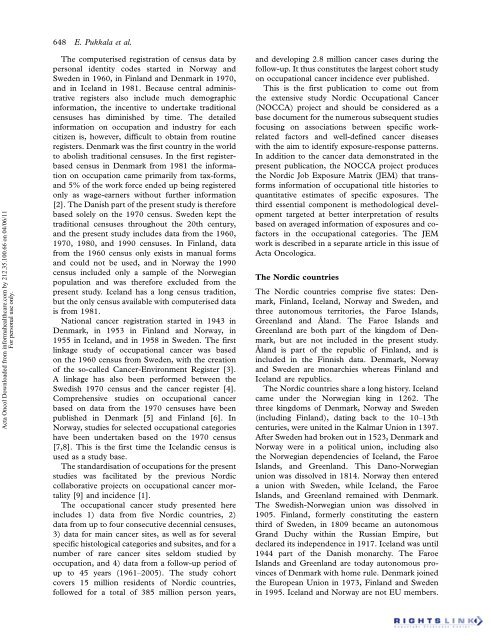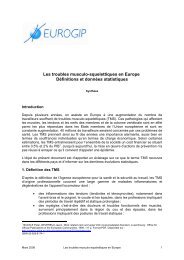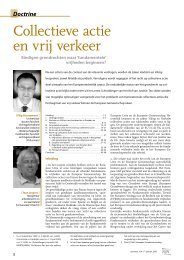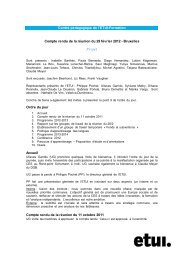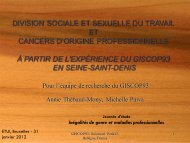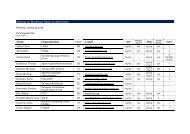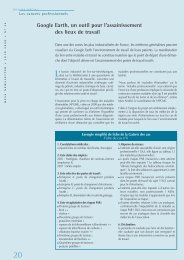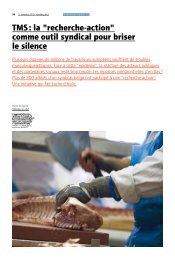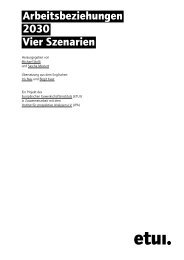Occupation and cancer - European Trade Union Institute (ETUI)
Occupation and cancer - European Trade Union Institute (ETUI)
Occupation and cancer - European Trade Union Institute (ETUI)
You also want an ePaper? Increase the reach of your titles
YUMPU automatically turns print PDFs into web optimized ePapers that Google loves.
Acta Oncol Downloaded from informahealthcare.com by 212.35.100.66 on 04/06/11<br />
For personal use only.<br />
648 E. Pukkala et al.<br />
The computerised registration of census data by<br />
personal identity codes started in Norway <strong>and</strong><br />
Sweden in 1960, in Finl<strong>and</strong> <strong>and</strong> Denmark in 1970,<br />
<strong>and</strong> in Icel<strong>and</strong> in 1981. Because central administrative<br />
registers also include much demographic<br />
information, the incentive to undertake traditional<br />
censuses has diminished by time. The detailed<br />
information on occupation <strong>and</strong> industry for each<br />
citizen is, however, difficult to obtain from routine<br />
registers. Denmark was the first country in the world<br />
to abolish traditional censuses. In the first registerbased<br />
census in Denmark from 1981 the information<br />
on occupation came primarily from tax-forms,<br />
<strong>and</strong> 5% of the work force ended up being registered<br />
only as wage-earners without further information<br />
[2]. The Danish part of the present study is therefore<br />
based solely on the 1970 census. Sweden kept the<br />
traditional censuses throughout the 20th century,<br />
<strong>and</strong> the present study includes data from the 1960,<br />
1970, 1980, <strong>and</strong> 1990 censuses. In Finl<strong>and</strong>, data<br />
from the 1960 census only exists in manual forms<br />
<strong>and</strong> could not be used, <strong>and</strong> in Norway the 1990<br />
census included only a sample of the Norwegian<br />
population <strong>and</strong> was therefore excluded from the<br />
present study. Icel<strong>and</strong> has a long census tradition,<br />
but the only census available with computerised data<br />
is from 1981.<br />
National <strong>cancer</strong> registration started in 1943 in<br />
Denmark, in 1953 in Finl<strong>and</strong> <strong>and</strong> Norway, in<br />
1955 in Icel<strong>and</strong>, <strong>and</strong> in 1958 in Sweden. The first<br />
linkage study of occupational <strong>cancer</strong> was based<br />
on the 1960 census from Sweden, with the creation<br />
of the so-called Cancer-Environment Register [3].<br />
A linkage has also been performed between the<br />
Swedish 1970 census <strong>and</strong> the <strong>cancer</strong> register [4].<br />
Comprehensive studies on occupational <strong>cancer</strong><br />
based on data from the 1970 censuses have been<br />
published in Denmark [5] <strong>and</strong> Finl<strong>and</strong> [6]. In<br />
Norway, studies for selected occupational categories<br />
have been undertaken based on the 1970 census<br />
[7,8]. This is the first time the Icel<strong>and</strong>ic census is<br />
used as a study base.<br />
The st<strong>and</strong>ardisation of occupations for the present<br />
studies was facilitated by the previous Nordic<br />
collaborative projects on occupational <strong>cancer</strong> mortality<br />
[9] <strong>and</strong> incidence [1].<br />
The occupational <strong>cancer</strong> study presented here<br />
includes 1) data from five Nordic countries, 2)<br />
data from up to four consecutive decennial censuses,<br />
3) data for main <strong>cancer</strong> sites, as well as for several<br />
specific histological categories <strong>and</strong> subsites, <strong>and</strong> for a<br />
number of rare <strong>cancer</strong> sites seldom studied by<br />
occupation, <strong>and</strong> 4) data from a follow-up period of<br />
up to 45 years (1961 2005). The study cohort<br />
covers 15 million residents of Nordic countries,<br />
followed for a total of 385 million person years,<br />
<strong>and</strong> developing 2.8 million <strong>cancer</strong> cases during the<br />
follow-up. It thus constitutes the largest cohort study<br />
on occupational <strong>cancer</strong> incidence ever published.<br />
This is the first publication to come out from<br />
the extensive study Nordic <strong>Occupation</strong>al Cancer<br />
(NOCCA) project <strong>and</strong> should be considered as a<br />
base document for the numerous subsequent studies<br />
focusing on associations between specific workrelated<br />
factors <strong>and</strong> well-defined <strong>cancer</strong> diseases<br />
with the aim to identify exposure-response patterns.<br />
In addition to the <strong>cancer</strong> data demonstrated in the<br />
present publication, the NOCCA project produces<br />
the Nordic Job Exposure Matrix (JEM) that transforms<br />
information of occupational title histories to<br />
quantitative estimates of specific exposures. The<br />
third essential component is methodological development<br />
targeted at better interpretation of results<br />
based on averaged information of exposures <strong>and</strong> cofactors<br />
in the occupational categories. The JEM<br />
work is described in a separate article in this issue of<br />
Acta Oncologica.<br />
The Nordic countries<br />
The Nordic countries comprise five states: Denmark,<br />
Finl<strong>and</strong>, Icel<strong>and</strong>, Norway <strong>and</strong> Sweden, <strong>and</strong><br />
three autonomous territories, the Faroe Isl<strong>and</strong>s,<br />
Greenl<strong>and</strong> <strong>and</strong> A˚ l<strong>and</strong>. The Faroe Isl<strong>and</strong>s <strong>and</strong><br />
Greenl<strong>and</strong> are both part of the kingdom of Denmark,<br />
but are not included in the present study.<br />
A˚ l<strong>and</strong> is part of the republic of Finl<strong>and</strong>, <strong>and</strong> is<br />
included in the Finnish data. Denmark, Norway<br />
<strong>and</strong> Sweden are monarchies whereas Finl<strong>and</strong> <strong>and</strong><br />
Icel<strong>and</strong> are republics.<br />
The Nordic countries share a long history. Icel<strong>and</strong><br />
came under the Norwegian king in 1262. The<br />
three kingdoms of Denmark, Norway <strong>and</strong> Sweden<br />
(including Finl<strong>and</strong>), dating back to the 10 13th<br />
centuries, were united in the Kalmar <strong>Union</strong> in 1397.<br />
After Sweden had broken out in 1523, Denmark <strong>and</strong><br />
Norway were in a political union, including also<br />
the Norwegian dependencies of Icel<strong>and</strong>, the Faroe<br />
Isl<strong>and</strong>s, <strong>and</strong> Greenl<strong>and</strong>. This Dano-Norwegian<br />
union was dissolved in 1814. Norway then entered<br />
a union with Sweden, while Icel<strong>and</strong>, the Faroe<br />
Isl<strong>and</strong>s, <strong>and</strong> Greenl<strong>and</strong> remained with Denmark.<br />
The Swedish-Norwegian union was dissolved in<br />
1905. Finl<strong>and</strong>, formerly constituting the eastern<br />
third of Sweden, in 1809 became an autonomous<br />
Gr<strong>and</strong> Duchy within the Russian Empire, but<br />
declared its independence in 1917. Icel<strong>and</strong> was until<br />
1944 part of the Danish monarchy. The Faroe<br />
Isl<strong>and</strong>s <strong>and</strong> Greenl<strong>and</strong> are today autonomous provinces<br />
of Denmark with home rule. Denmark joined<br />
the <strong>European</strong> <strong>Union</strong> in 1973, Finl<strong>and</strong> <strong>and</strong> Sweden<br />
in 1995. Icel<strong>and</strong> <strong>and</strong> Norway are not EU members.


